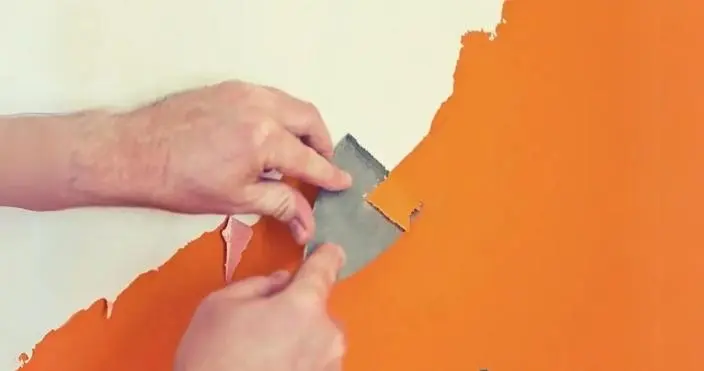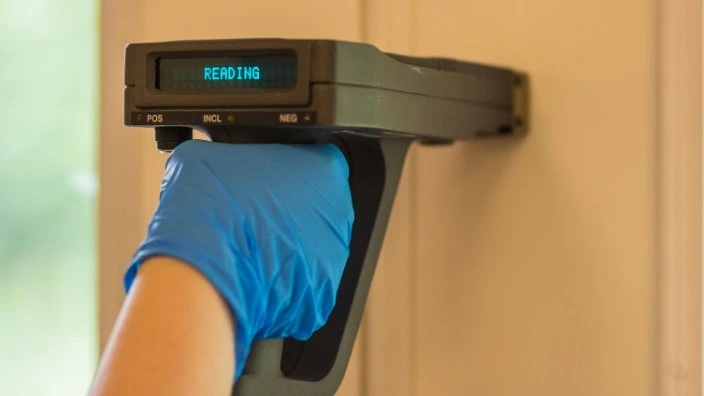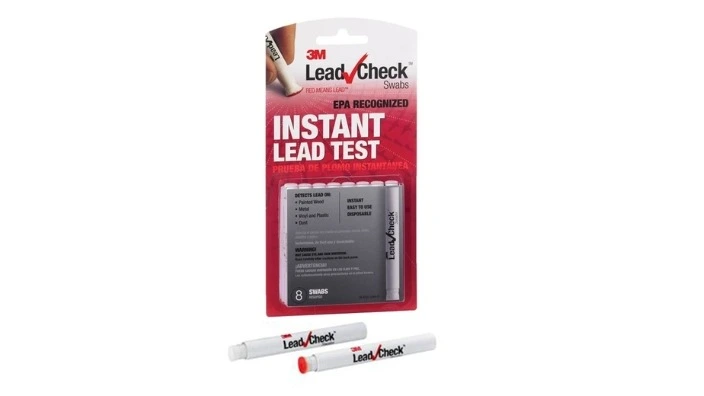Considering the hazards of lead-based paint it is the duty of every man to make endeavours to identify lead paint with or without a kit in order to secure the life of the family members. Remember, the answer to the question ‘how to identify a lead paint’ is not an easy task.
Lead-based paint may exist on furniture, metal and or toys of the kids, therefore ample time and observation is needed to hold a comprehensive survey so the family can stay safe from the hazards of the lead paint.
However, if the construction is new and it is traceable to find out the first owner who started construction of the premises or the builder is easily traceable so things become easier to trace and address the untapped and unknown issues, which are likely to appear after a few years.
Table of Contents
- Significance of Knowing Lead Based Paint
- Lead-Based Paint
- What is lead paint and why it is crucial to identify a lead paint?
- Difference between Asbestos and Lead Paint
- Adverse effects of lead on health
- Is There Lead Paint at Your Residence?
- How to Identify Lead Paint in Your Home?
- Do you have lead paint at your home unidentified?
- What more is to be done to identify lead paint?
- When the lead paint is identified: how to remove that?
- Legal implications for the violation and a case study
- Conclusion
- FREQUENTLY ASKED QUESTIONS:
Significance of Knowing Lead Based Paint
In order to recognize or check lead paint, it is incumbent upon the residents of a house or office as the case may be to get the premises surveyed with the help of some professional or with the use of the kit to know where the lead paint is existing followed by the measures to secure life from threats of being inflicted by that.
The question is normally asked ‘How do I know if something has lead paint’ The answer varies from case to case. In cases where old construction is involved, and it is not possible to trace the first owner or the construction company, which laid the structure of the building help from some professional service provider can be sought.
Lead-Based Paint

Lead paint was seen in thousands of ancient old houses in the overall US. This paint could have a negative health side effect. Whenever you are trying to make your home look new by renovating it. Do not just ignore the presence of lead paint in your home if your home is too old.
You need to first identify lead paint and do something about it. You need to eliminate it from the entire house whether it is on your doors or anywhere else. Do not ignore it. Do not just put the life of your loved ones at stake by just ignoring it completely and doing nothing about it.
What is lead paint and why it is crucial to identify a lead paint?
Lead-based paint or lead paint were the two terms used in the 1980s era to refer towards lead paint so that the drying mechanism could be accelerated. It was also used for durability and maintenance of moisture resistance with the benefit that the paint was cheap.
At that time, lead paint was considered to be the best technique to manufacture paint. In 1978 US, the government banned using lead in paint manufacturing because of the health risks that it led to for the population.
Difference between Asbestos and Lead Paint
Asbestos

Asbestos refers to bundle-like mineral fibres which could be further separated into durable thin threads to use in industrial and commercial applications. Heat resistance is present in the fibres as well as the resistance against fire, and are the non-conductors of electricity. Asbestos negatively impacts breathing in which the microscopic fibre is also breathed into the air.
When the soil is disturbed then the fibre is witnessed in the air. The extent of asbestos exposure is dependent upon various factors including material type, weather conditions, location, and moisture.
Lead Paint
One of the highly toxic metals found in the environment is lead. It is found in the soil, air, homes, and even in water. We are exposed to lead when we perform different activities including activities related to industrial facilities, gasoline, and lead-based paints at home. Lead has been one of the substantial materials in solder, paint, brass, batteries, bullets, and radiators.
Exposure to lead poses life-threatening health risks including cognitive issues, breathing issues and many other health issues. Lead exposure is very harmful to the pregnant woman’s health. Methods to avoid lead exposure should be utilized at home.
Lead poisoning could be avoided in residences or towns by increasing the knowledge about the hazardous repercussions of lead exposure to health. This could also be achieved by diminishing the use of lead paint, and the soil that is contaminated by lead.
Adverse effects of lead on health

As mentioned earlier, lead exposure has some devastating health risks for human beings. Most of the time there are breathing problems and cognitive issues. Healthcare studies have also validated that even a small increase in young children’s lead exposure would impose immediate, serious and devastating health hazards.
On the other hand, though asbestos also poses a health risk but its exposure risks are little as compared to the health risks associated with lead exposure. For other type of medical problems arising out of similar nature of product you can read our another article How to Get Fiberglass Out of Clothes
Lead exposure affects the nervous system and can also cause a range of health effects including but not limited to behavioral problems and learning disabilities to seizures and death. Children under the age of six years old are most at risk.
If the problem is not detected early, children with high levels of lead in their bodies can suffer from the following medical issues: -
- Damage to the brain and nervous system
- Behavior and learning problems, such as hyperactivity
- Slowed growth
- Hearing problems
- Headaches
- In some cases ingestion of lead, seizures, coma and even death
Lead can amass in our bodies over time, where it is stored in bones along with calcium. During the period of pregnancy, lead is released from bones as maternal calcium is used to help form the bones of the fetus. This is particularly true if a woman does not have enough dietary calcium, lead can also be easily circulated from the mother's bloodstream to the fetus.
Mothers with high levels of lead in their bodies can expose their developing fetuses, resulting in serious problems including: 1.Miscarriages 2.Premature births or low birth weight 3.Brain damage, decreased mental abilities and learning difficulties 4.Reduced growth in young children
Long-term Health Impacts of Asbestos and Lead Exposure:
Asbestosis
The possible and long-term health impacts of asbestos exposure include irreversible lung damage, breathing difficulty, chest discomfort, round toe and fingernails, and coughing are some of the primary long-term health issues associated with lead and asbestos exposure.
Lead
Central nervous system, brain damage, seizures, coma, mental impairment, and breathing issues are some of the prominent and proven health issues associated with even a small exposure to lead for human beings. More health issues include headaches, high blood pressure, muscle and joint pain, focus and memory issues, abdominal pain and nausea, mood disorders, development issues in kids, and fertility issues in women and men. All these are devastatingly fatal health risks which should be avoided on an immediate basis.
Is There Lead Paint at Your Residence?
In the case of a newly built home it is not possible but if your residence was built before the 1980 era then definitely there is a possibility that your home would be having lead paint anywhere which could be fatal for you and your younger children.
Always keep your family safe by properly investigating the presence of hazardous chemicals like lead or asbestos paint. CDC has an estimation of about 24 million homes in the US that are affected by serious lead-paint hazards.
How to Identify Lead Paint in Your Home?

Following are some ways in which you could identify lead paint in your home: •Conduct thorough research about the source and age of lead paint. •Using a DIY paint kit for testing. •Looking towards a professional analysis and testing kit from a professional accredited lab. •Detailed Steps to Identify Lead Paint in Your Home
There are few steps to determine the existence of lead paint in your house, for which you need to undertake some of the actions: -
Step 1: Knowing the Time When Your Residence was built
To identify lead paint in your home, you first need to know the year when the home was built. The older the home, the more chances are there of having lead paint. Families are posed with greater threats of experiencing health risks as compared to individuals.
If you have a child of age below 6 years, then living in New York would require your landlord to conduct annual inspections of your home to eliminate every hazard associated with lead paint.
Step 2: Identify lead paint symptoms
The second step is to reckon the initial signs associated with lead poisoning at your home. If your family experiences health symptoms leading to the expectation of lead poisoning, then it could be a sign of the presence of lead paint in your home. In that case, an urgent inspection of the paint is necessary. You should consult an inspector in such a case.
Step 3: Evaluating Signs of Damaged Paint

It is noteworthy that you will witness the hazards of lead paint only when the paint is deteriorating. Satisfactory maintenance of the lead paint when it is also having lead in it, does not cause an immediate health issue so it is necessary to see if your lead paint is in good condition and not deteriorating.
When the paint is wrinkled or damaged, then children could ingest accidentally leading to serious health complications and even leading to fatal consequences.
Step 4: Checking the Paint’s Sub Layers
For effective identification of the lead paint, sub-layers of the paint also need further examination. Chipping could be a sign of identification too.
Step 5: Testing Kits for Home Testing

A suspicion of the presence of lead paint could also force you to buy a home lead testing kit. These kits change their colors to indicate your identification of paint. The home testing kits are cheap but are also inaccurate. They do not meet your purpose effectively and the best way is always to contact the right person specialized in this job. It would be a costly alternative, but a safe one for you and your entire family.
After undertaking the above test, one cannot say with certainty that he has identified the lead paint as currently, no mechanism is there to analyze the presence of lead paint in the existing structures with absolute correctness. However, putting some more effort into identifying lead paint could bring forth the results for your consumption.
Do you have lead paint at your home unidentified?
If you think that your residence is also one of the hundreds and thousands of homes in the US dealing with the same issue then you should first identify lead paint, the type of paint you have got to ensure the protection of your family.
Furthermore, when you observe that your family’s safety and health start deteriorating then immediately consult a doctor before it is too late. You should have planned proper treatment for them and should have to plan an immediate analysis of your paint especially if you are also living in an old home like millions of US residents.
Like lead paint asbestos also has health issues for the residents of the building; however in comparison with the problems associated with lead paint; those are tiny. Let’s get in some deep to compare asbestos and lead.
What more is to be done to identify lead paint?
Digging deeper ensures the best practice to test lead paint presence. Some actions could be taken through which you could search effectively about the indicators associated with lead paint. When you will continue to observe all those factors then this could determine if testing could be done or not.
The prominent action among all of them is the process of alligatoring. Alligatoring takes place with wrinkling and cracking of the paint by creating a specific pattern that is similar to reptilian scales. This could be a sign of lead containment.
Another type of sign which you could observe is the chalky residue when the paint is rubbed. It is also noteworthy that chalky or scaly spot is harder to be identified because it consists of the new paint layering. Therefore, it would be a great idea to examine the baseboards, closets, and behind-the-home appliances.
When the lead paint is identified: how to remove that?

After confirmation of the presence of lead paint at home, it is significant to have a knowledge of the effective and safe ways of lead paint removal so that it could not have any health risks to your loved ones and you. If you see the good condition of the paint with no chipping, peeling, flaking or cracking, then you might be able to have paint over it instead of having it removed.
Encapsulants would be used to paint over the lead paint. Encapsulants are special types of paints having the capacity to prevent paint from producing harmful lead dust or flakes. They also form a protective layer which prevents lead paint to come into contact with other people.
Another option available is the removal of lead paint completely. However, it is very crucial to consider that removal of lead paint should be done safely and wisely in light of the guidelines set by the EPA.
For this purpose, it is always better to consider hiring a contractor involved in lead abatement activities. According to your residential situation, the lead abators could use a number of tools for the paint removal. They may use HEPA high-efficiency air vacuum sanding or liquid paint remover scrapping.
If the paint is being removed to renovate your home on a larger scale, then one could also opt to use the replacement of all surfaces and materials such as the woodwork, doors, windows or drywall.
A lead inspector may use XRF analyzers that are handheld that have the capability to fire an X-ray beam within the sample of that paint. It then evaluates the resulting signatures and measures them so that the level of lead could be identified in the paint.
More than 0.5 milligrams per square meter lead measurement is said to be an alarming and positive sign of lead mixing in paint. Again all these procedures need more care and accuracy so that there could be no lead paint part visible in your home as it could pose a greater health risk to your family.
Legal implications for the violation and a case study

Lead disclosure rules via section 1018 provide that the landlords, sellers and their agents must mention to their prospective tenants and purchasers required disclosures about lead-based paint. Although the law has been old for 25 years, to enforce the provisions, the Environmental Protection Agency continues to find people who do not comply, sometimes with tragic consequences.
As a case study, we can quote the example of a renovation company, which pleaded guilty on account of violation of the rules by non-complying with the lead-safe work practices.
On May 22, 2018, Bitner Brothers Construction Co., Inc. (hereinafter referred as ‘Bitner Brothers’) of Carlisle, Pennsylvania, entered a two-count guilty plea for knowingly violating lead-safe work practices under federal law. As per the facts of the case, in February 2017, Bitner Brothers conducted work inside two apartments in Harrisburg, Pennsylvania where families with small children were present. The company failed to comply with the requirement that power grinding equipment have a shroud or containment system equipped with a HEPA vacuum during the renovation. The 2017 events marked the second time in three years that the EPA had investigated the company for repair and painting rule (RRP) violations. As part of the plea agreement, the defendant company, and its President and owner, Charles H. Bitner, Jr., were directed not to undertake new work contracts that require a special skill, training or certification related to the handling and/or management of lead, including LBP, for the period of probation. The Magistrate Judge accepted the plea and set a sentencing date. The maximum penalty is a $200,000 fine and one year in prison, as well as the costs of prosecution or probation and a special court assessment. On September 18, 2018, Bitner Brothers was sentenced to two years of probation, a $10,000 fine and a $125 special assessment fee.
Conclusion
It is safely inferred from the facts that the presence of lead paint in your home is risky in terms of the health of your family, and it is your responsibility to make endeavours to identify lead paint y by using different methods and kits.
However, before doing that, you must also know the whereabouts of the actual year in which your house was built and the age and deterioration level of your paint. You may find a lead testing kit from the market for the paint removal but it is not a recommended solution of identification because it is cheap but inaccurate.
The best solution is to use the services of a professional specialist who is capable of identifying the type of paint in your home and the extent to which it could pose a threat to you and your family, especially the kids.
Landlords are also required to inspect their homes annually in case of an old building. In a nutshell, identifying lead paint at an early stage can prevent the family from suffering from the hazards of the lead paint and using the proper methods to identify lead paint and consequential removal ensures a healthy and trouble-free life for your family.
FREQUENTLY ASKED QUESTIONS:
How can you tell if paint is lead?
Among other signs of lead in the paint; the presence of alligatoring is known to most people. It appears in the form of a reptilian scale after the cracks in the wall. Another sign appears when paint creates a chalky residue in response to rubbing.
How do you know if the paint is lead-free?
In order to test whether the surface has been covered by using the lead paint or not, a kit has been made available in the market, whose performance is undoubtedly secure and accurate. The kits are easily available in the paint shops and the testing doesn't require any professional help.
Can you just paint over lead paint?
However, it is not a preferred solution because it could reduce the chances of inflicting injuries but would not completely remove the possibility of hazards. The process of putting fresh paint over lead paint is called ‘encapsulation’ an approved means by EPA to remedy the lead paint. Remember the paint you are planning to buy would require a special material ‘encapsulant’ inclusive of the paint to override the effects of lead paint.
What color was lead paint?
It's white in colour. Initially, it was in demand for its whitening look of the premises; however, later the adverse effects containing the poisoning also became known to the people. Thus it was banned in most countries but the problems persist in the houses constructed outstation.
When alligatoring appears on the buildings of a wall?
Amongst other signs; the appearance of alligatoring is another result of cracks and wrinkles in the building showing the existence of lead in the paint. Its pattern seems like a reptilian scale. The existence of lead in the paint can also be checked by rubbing if it produces a chalky residue, it contains lead.


















